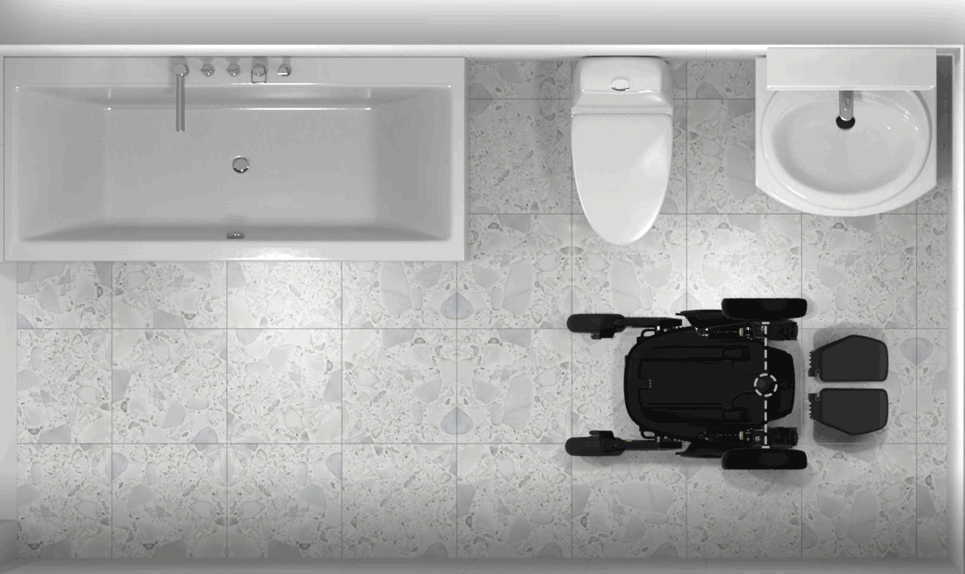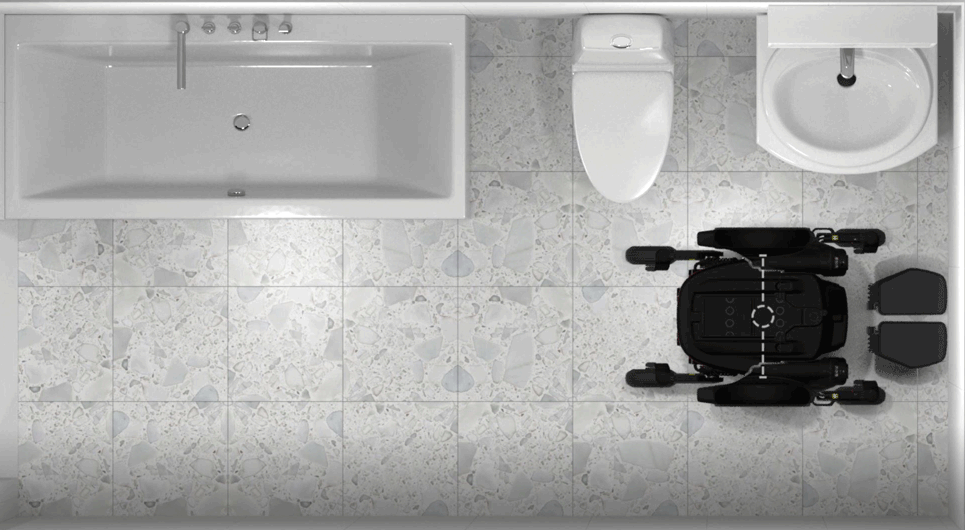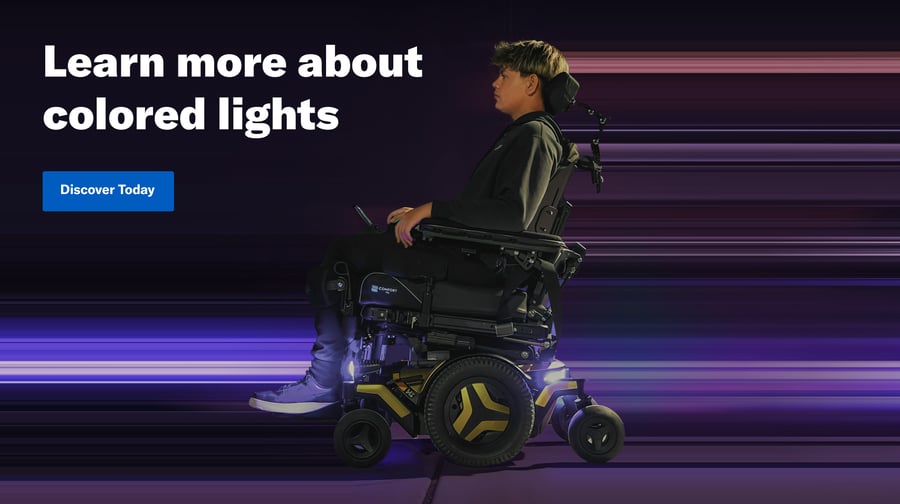Part 1 in our two part series exploring the potential benefits and uses of front wheel drive power wheelchairs. For more information on Standing Wheelchairs, check out Landon's Journey to Standing.
We at Permobil have over 50 years of redefining not just ability but also mobility. Today we are focusing on front wheel drive solutions and our story really starts with our founder, Dr. Per Udden who made the first Permobil power wheelchair in the basement of his hospital in Sweden. Dr. Udden believed in a better solution that allowed his clients and patients to get independent mobility, and with this idea in mind he created the first power wheelchair. Early on, Permobil has believed in the benefit of front wheel drive as an ideal platform for indoor and outdoor mobility.
So how do you know if a Front Wheel Drive power wheelchair is right for you?
If you are looking for a power wheelchair that is comfortable to ride in, able to maneuver close to work and transfer surfaces, while still able to navigate and track across a variety of terrains, Front Wheel Drive might be right for you!
Before we begin to talk about the benefits of Front Wheel Drive (FWD), we want to point out that when you're selecting a mobility base, front wheel drive may not work for every single person, and a different drive wheel configuration might work better to meet that person's needs. An individual's needs, preferences, activities and environments of use should all be taken into consideration when configuring the wheel drive that works best for the individual.
Let’s look at some of the reasons FWD might be the right mobility base for you:
- Proximity to surfaces for function
- Navigation of tight corners
- Obstacle Negotiation
- Enhanced Steering
- Smooth Ride
- Stable Base of Support
We're going to focus on the first two reasons you might consider FWD as the right mobility base for you today, but check back next week when we take a look at the rest of the list.
Proximity to Surfaces for Function
With front wheel drive, your feet can be tucked further back allowing you to get closer to surfaces for function. A front wheel configuration does not have caster wheels that are interacting with the environment and potentially getting in the way of your desired position. Front wheel drive also allows your legs to be positioned back behind the drive wheels, getting you even closer to desks or work services or table tops like you see in our photo below. If appropriate, certain configurations of F-Series power wheelchairs do not require front anti-tip bars, which only continues to improve your environmental accessibility (check with manufacturer for safety recommendations).
Let’s take a look at a real-life scenario with the young lady in the photo below. She is getting as close to the jewelry counter as possible with her front wheel drive power wheelchair. Someone doesn't have to bring the jewelry up to her or over to; she can drive right up to the counter and get as close as possible with her front wheel drive base configuration.

Navigation of Tight Corners
Let's take a look at what the research shows us about how we should select a wheelchair base and what features and functions do we want from our power wheelchairs? An article from Koontz and colleagues outlines the benefits and potential barriers of the different drive wheel configurations. The research shows that a front wheel drive power wheelchair requires the least amount of space to make a 90 degree turn while a middle drive power wheelchair requires the least amount of space for 180 degree turn. Finally, the research reports that mid-wheel and front wheel drive are better for maneuvering in confined spaces in comparison to a rear-wheel drive power wheelchair. What the research is essentially saying is mid-wheel drive turns in one position better and front wheel drive navigates 90 degree turns better.
So when we apply that research into everyday mobility, what does our environment require us to do when we are in a power mobility device? Are we making a lot of a 180 degree turns or are we really actually only turning 45 degrees or 90 degrees at a time? A 90 degree turn may occur for example when entering a wheelchair accessible van, being able to make a sharp turn into the passenger or driver’s side is critical.
There are not a lot of environments where you have to do a complete turn in space and go right back in the direction you started from. This may occur in an elevator for example; however more often we are making small changes in our course correction than making big turns where we need to completely change our direction.
We're going to give you a couple of examples of how front and mid-wheel drive can be used in terms of navigation and maneuverability. The image below is an overhead view of a front wheel drive chair turning in a bathroom scenario with the sink on the top right. That pivot point of the front wheel drive chair allows the person to make a sharp turn which is that 45 or 45 degree turn. The last image is at a 90-degree turn and you are directly centered over that sink. You can get up very close to that sink and be centered over it. This is the same as how you would enter a vehicle or the way you would do a commode transfer.

1. The approach to the sink. The dotted line is highlighting the front wheel drive pivot point and how you can line up the pivot point with the end of the sink prior to turning.
2. Turning towards the sink. As the left turn is initiated, the left wheel remains stable and the right wheel is moving toward the destination.
3. Finally, destination is reached and client can proceed to pulling in as close as needed to the sink. No repositioning of the wheelchair base is needed, you are centered over the work surface.
Let’s compare this to a mid-wheel drive. As you can see the pivot point is actually farther away from the center of the sink. To get centered directly over the sink, a multipoint turn would have to be made to get closer to the wall on the right and get closer to the sink. Now at this point, a 180-degree turn is no longer effective and the turn radius of front wheel drive is more appropriate in this setting.

1. Look at the pivot point of the Mid wheel drive, since it more centered on the base, it means more of the chair is past the destination prior to initiating the turn.
2. As the MWD begins to make the turn, the left wheel is moving back and the right wheel moving forward, and therefore the person in the chair is not aligned with the desired location.
3. In the final position, the MWD chair does not allow the chair to be centered with the desired surface in one single movement. It would then require a series of multi-point turns or base repositioning.
One of the last things from this research study that we really wanted to highlight was a short session in a front wheel drive chair is not going to give the client the best ability to make the decision on what wheel drive is right for them. A wheelchair user needs to be coached to understand how to drive and how to maneuver a front wheel drive differently.
I really love this quote where the researcher states, “The handling of front wheel drive PWCs may be more intuitive for some users because the center of rotation is toward the front of the wheelchair, enabling the user to initiate a turn at the bend versus having to judge when to begin initiating a turn in order to accommodate a wider front-end swing angle.” This is a little bit lost in our training techniques since we don’t spend a lot of time training someone between front and mid-wheel drive.
The quote is really exemplified in these two images where we can see that if you're navigating down a hallway. front wheel drive allows you to turn as soon as you see the open bathroom door. It allows you to get close to the wall and make a very tight turn and go into your environment versus having to go past the door, wait until you're centered in the doorway, and then enter.
Check back next week when we go over the rest of the reasons you might consider a Front Wheel Drive power wheelchair.
Koontz, A. M., Brindle, E. D., Kankipati, P., Feathers, D., & Cooper, R. A. (2010). Design features that affect the maneuverability of wheelchairs and scooters. Archives of physical medicine and rehabilitation, 91(5), 759-764.
 Jennith Bernstein, PT, DPT, ATP/SMS
Jennith Bernstein, PT, DPT, ATP/SMS
Regional Clinical Education Manager
Jennith Bernstein received her masters in Physical Therapy at North Georgia College & State University and returned to complete her transitional DPT at University of Texas Medical Branch in 2014. While at Shepherd Center, Jennith, initiated a “Seating Champion” program to improve the inpatient and day program clinicians understanding of complex seating, pressure management and skin protection as well as research reviews, advanced programming and adjustments. She was also part of a center wide multidisciplinary focus group for reduction of hospital acquired skin breakdown. Jennith has served as a volunteer teacher at the Universidad Mariano Galvez in Guatemala, instructing spinal cord injury curriculum as well as seating and mobility. Jennith has presented at national conferences such as RESNA, ISS, and the APTA NEXT conference. Jennith has been a practicing PT for 12 years and spent the last 10 years at a model SCI center (Shepherd Center) in Atlanta, Georgia. Jennith joined Permobil as the Clinical Education Manager for the Central Region in 2016.

